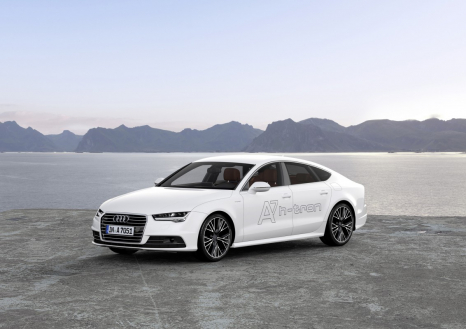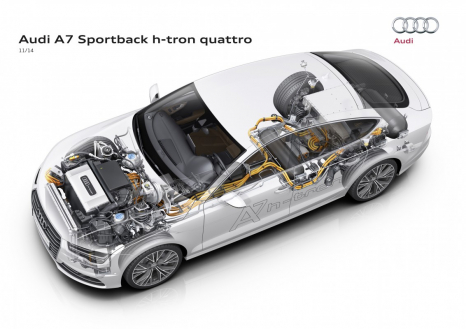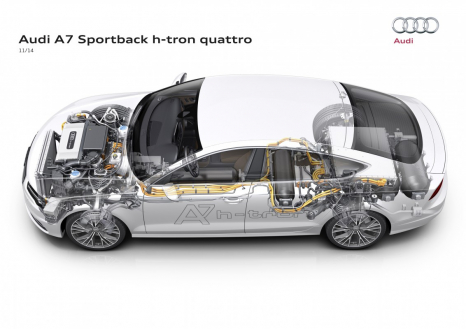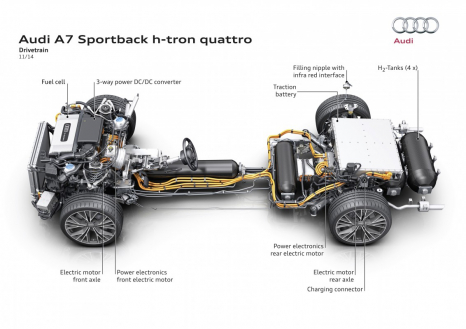Audi A7 Sportback h-tron quattro
It sprints from 0 to 100 km/h (62.1 mph) in 7.9 seconds and reaches a top speed of 200 km/h (124.3 mph). It can cover more than 500 kilometers (310.7 mi) on a single tank, with nothing more than a few drops of water leaving the tailpipe. The A7 Sportback h‑tron quattro* uses a 170 kW electric drive system with a fuel cell as the energy source. Each of the two electric motors drive the wheels of one axle. The Audi technical concept car is a true quattro and thus unique among fuel cell automobiles.
The Audi A7 Sportback h‑tron quattro joins the Audi e‑tron and g‑tron lineup of alternative-drive models and features another technology of the future: The “h” in its name denotes the chemical element hydrogen.
Like the engine of a conventional A7 Sportback, the fuel cell of the Audi technical concept car is mounted in the front. It comprises over 300 individual cells that together form a stack. The core of each of these individual cells is a polymer membrane. There is a platinum-based catalyst on both sides of the membrane. Hydrogen is supplied to the anode, where it is broken down into protons and electrons. The protons migrate through the membrane to the cathode, where they react with oxygen present in air to form water vapor. Meanwhile, outside the stack the electrons supply the electrical power – depending on load point, the individual cell voltage is roughly 0.6 to 0.8 volts.
The fuel cell operates in the high-voltage range. The most important auxiliaries include a coolant pump and the recirculation fan – a turbo compressor that forces air into the cells, returning unconsumed hydrogen back to the anode and thus increasing efficiency. These components have a high-voltage electric drive and are powered by the fuel cell. Because the exhaust system transports only water, it can be made of lightweight polymer.
There is a separate cooling circuit for cooling the fuel cell. The unit, which operates at a temperature of approximately 80 degrees Celsius, places higher demands on the vehicle cooling than an equivalent combustion engine, but achieves superior efficiency of as high as 60 percent – nearly double that of a typical combustion engine.
Cold starting is possible at temperatures down to -28 degrees Celsius. A heat exchanger and a thermoelectric, self-regulating auxiliary heating element maintain pleasant temperatures in the cabin.
Battery under the luggage compartment: the plug-in hybrid concept
A special feature of the A7 Sportback h‑tron quattro is its plug-in hybrid concept – this represents a logical evolution from the Audi A2H2 and Q5 HFC test cars. The technology demonstrator is equipped with an 8.8 kWh lithium-ion battery taken from the Audi A3 Sportback e-tron*. It is located beneath the luggage compartment and has a separate cooling circuit for thermal management.
The high-performance battery makes the ideal partner to the fuel cell. It can store energy recovered from brake applications and supply considerable power for full-load boosting. On battery power, the Audi A7 Sportback h‑tron quattro covers as much as 50 kilometers (31.1 mi). Depending on voltage and amperage, a full charge takes between two and four hours.
The battery operates at a different voltage level than the fuel cell. For that reason, there is a DC converter (DC/DC) between the two components. This tri-port converter is located behind the stack. The power electronics in the front and rear of the vehicle convert the direct current from the fuel cell and battery into alternating current for the two electric motors.
Fascinatingly innovative: quattro drive with no mechanical parts
The Audi A7 Sportback h‑tron quattro is the first fuel cell car with quattro drive – more specifically with an e-quattro drive – that has no mechanical connecting parts. The front electric motor drives the front wheels; the unit in the back the rear wheels. Torque at both axles can be electronically controlled in the event of slip and steplessly varied. The e‑quattro concept requires precise coordination of the electric motors – the technology demonstrator offers the sporty, stable and high-traction drive of a production car with mechanical quattro drive.
The electric motors, which together with the voltage converters are cooled by a low-temperature circuit, are permanently excited synchronous machines. Each of them has an output of 85 kW, or 114 kW if the voltage is temporarily raised. Maximum torque for each is 270 Nm (199.1 lb‑ft). The electric motors’ housings incorporate planetary gear trains with a single transmission ratio of 7.6:1. A mechanical parking lock and a differential function round off the system.
Driving in the Audi A7 Sportback h‑tron quattro offers the full performance of electric drive in conjunction with the advantages of the new e‑quattro. The silent thrust is available in full from the start. At full load, the fuel cell reaches maximum output within one second, more dynamically than a combustion engine because the entire drivetrain includes just a few mechanical parts.
With 540 Nm (398.3 lb‑ft) of propulsive power at its disposal and tipping the scales at only around 1,950 kilograms (4299.0 lb), the Audi A7 Sportbac h‑tron quattro races from a standstill to 100 km/h (62.1 mph) in 7.9 seconds. Its top speed is 200 km/h (124.3 mph) – a top figure for its field of competitors. When the driver presses the EV button, the technology demonstrator drives solely on battery power. Switching from automatic transmission mode D to S increases the level of energy recovery when braking, so that the battery is charged up effectively during sporty driving. Braking is also generally all-electric. The four disk brakes only become involved if more forceful or emergency braking is required.
Range of over 500 km (310.7 mi): the hydrogen tanks
The four hydrogen tanks of the Audi A7 Sportback h‑tron quattro are located beneath the base of the trunk, in front of the rear axle, in the center tunnel. An outer skin made from carbon fiber reinforced polymer (CFRP) encases the inner aluminum shell. The tanks can store around five kilograms (11.0 lb) of hydrogen at a pressure of 700 bar – enough to drive over 500 kilometers (310.7 mi). According to the NEDC, fuel consumption is roughly one kilogram (2.2 lb) of hydrogen per 100 kilometers (62.1 mi) – an amount with an energy content equivalent to 3.7 liters (1.0 US gal) of gasoline.
The tank flap is in the right side section of the five-door coupe, concealing a filler connector for the hydrogen. Fully refueling with H2 takes around three minutes, roughly the same as with a conventional automobile. The tanks communicate with the refueling system via an infrared interface, indicating the pressure and temperature levels in each tank for optimal refueling.
Status 02/2015



